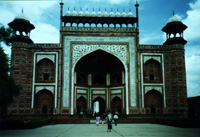
Taj Mahal is situated in the city of Agra, India - approximately 200 kilometres south of New Delhi. Between the 16th and 19th century, Agra was the capital of the Mughals, the Muslim Emperors who ruled Northern India during this time. Emperor Shan Jehan ordered the building of the Taj Mahal in honour of his wife, Arjumand Banu, better known as Mumtaz Mahal.
But as National Geographic reports (March 2001), there was more Jehan did to honour his wife: a 24 acre garden called the Mahtab Bagh was establish to be enjoyed at night.
Photo: Taj Mahal - still opportunities for new explorations.
This revelation come through a cooperation between the Archaeoligical Survey of India and the Sackler Gallery of the Smithsonian Instituion in Washington, D.C. In an new book with the title The Moonlight Garden: New Discoveries at the Taj Mahal. From the scientific work they documented that the garden was an integral part of the famous tomb complex.
The Empress tragically died whilst giving birth to their 14th child in 1630. Distraught by his loss, the Emperor decided to build his wife the most beautiful sepulchre ever - a monument of eternal love.
The mausoleum is part of a vast complex comprising the main gateway or Darwaza, a beautiful garden or Bageecha, the mosque or Masjid, the rest house or Naqqar Khana, and the Taj Mahal or Rauza.
Photo: Taj Mahal - this monument is synonymous with India, but first and foremost this is an monument related to strong love.
After nearly 20 years of hard work by skilled craftsmen, this great monument was finished. No one know actually who designed the Taj, although Ustad Ahmad Lahori, the Indian architect is most likely. The origin of the name the "Taj Mahal" is not clear. Court histories from Shah Jehan's reign only call it the rauza (tomb) of Mumtaz Mahal. It is generally believed that "Taj Mahal" (usually translated as either "Crown Palace" or "Crown of the Palace") is an abbreviated version of her name, Mumtaz Mahal (Exalted One of the Palace).
Change of colours - mood of the women
The monument is made of white marble, but the tomb is set against the plain across the river and it is this background that works its magic of colours that, through their reflection, change the view of the Taj. The colours change at different hours of the day and during different seasons.
For they who have the most beautiful woman, should think twice before they build her a monument, especially if it takes many years - as it usually does with big palaces. Even if you have the strongest love to her, you should take your time to consider it. Be aware of that moods of women change quickly.
You can see that Taj Mahal is like a jewel. Its sparkles in moonlight. Stones inlaid into the white marble on the main mausoleum catch the glow of the moon. The Taj is pinkish in the morning, milky white in the evening and golden when the moon shines. This monument is also made for a woman, but it also reminds about a woman. These changes, they say, symbols the different moods of woman! It could be bad, but maybe these colours are not the worst???!!!
Stein Morten Lund, 10 April 2001
Additional information
Read more about exciting destinations and new explorations on our web site.
